The Impossible Made Possible
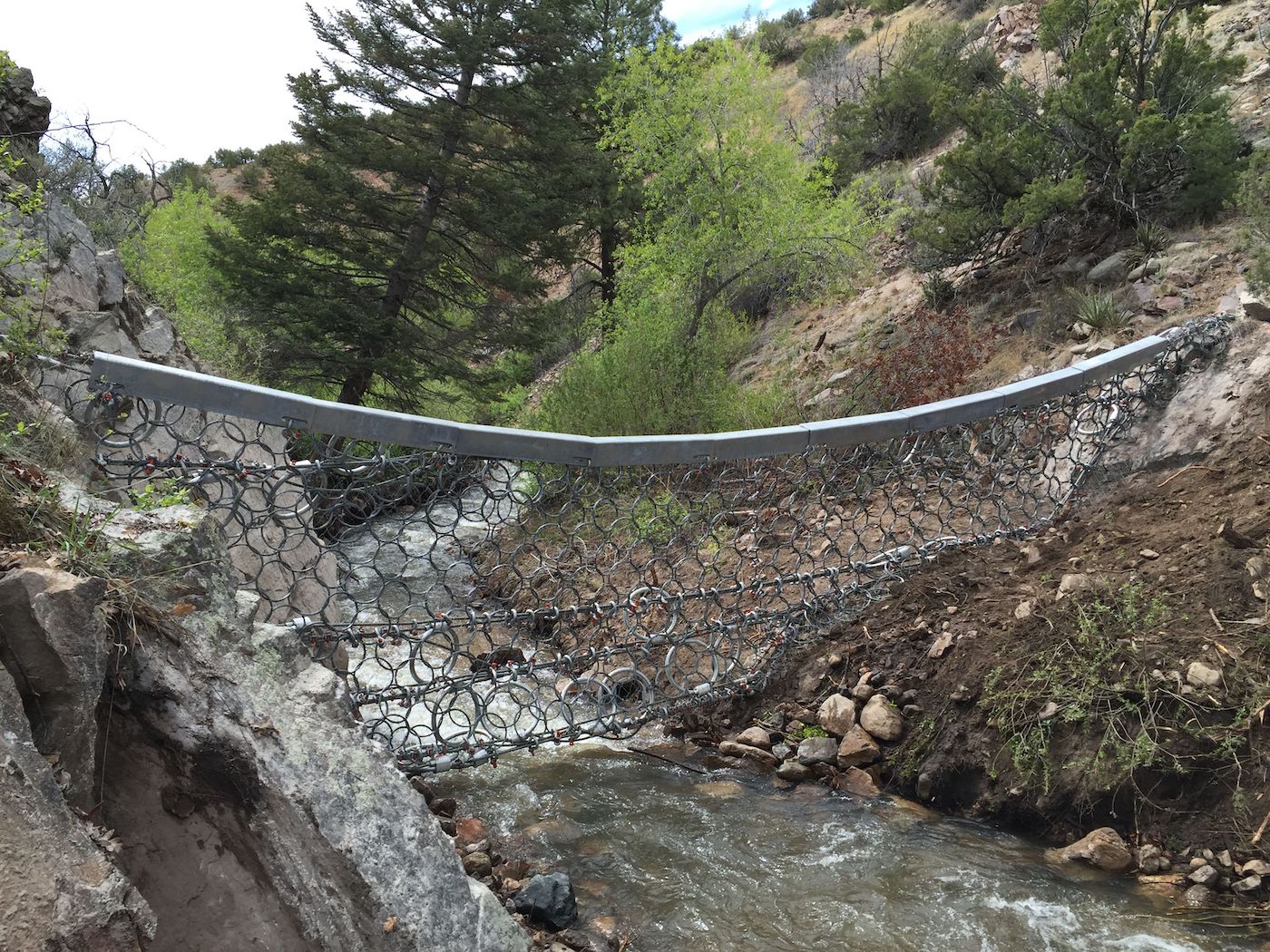
While most of us in Montecito were making merry over the holiday season, former City of Santa Barbara Fire Chief, Pat McElroy, who is now Executive Director of the Partnership (Partnership for Resilient Communities), was pounding the halls of government, along with Montecito land use attorney Joe Cole, permitting guru Suzanne Elledge, and local government consultant Mary Rose, trying to do the impossible – secure emergency government permitting authority for the installation of privately-funded ring nets to hold back boulders and other debris in the canyons above Montecito. The intent is to protect Montecito for the next five years from a repeat of the debris flow that took the lives of 23 of our friends and neighbors and destroyed or damaged over 400 homes and businesses one year ago on the deadly night of 1/9/18.
The Emergency Permitting Process
The permitting process involved negotiation and environmental approval from the U.S. Army Corps of Engineers, the California Department of Fish and Wildlife, the California Water Quality Control Board, the U.S. Forest Service and the County of Santa Barbara. That process would normally take at least four years, but the Partnership team, with considerable cooperation from the County, won approvals in a record four months.
The hard-won permit approvals come with strict guidelines, including a guarantee of ongoing maintenance as well as an ability to fund ultimate removal of the flexible debris nets we manage to install. The Partnership will also be required to inspect the nets every two weeks. In the event of a storm, the debris nets must be repaired and/or emptied within 72 hours. These requirements add another $2 million to the $5 million we had originally budgeted for the first 11 ring net installations.
The nets will sit three to five feet above streams so wildlife can swim or crawl under them. Federally endangered steelhead trout and the California red-legged frogs were studied and protected by biologists John Storrer and Jessica Peak, hired by the Partnership to gain permit approval. Sites that included hiking trail crossings were rejected in response to environmental priorities.
Hazardous Conditions Still Exist in Montecito
Montecito’s steep canyons (five in all: Cold Spring, Hot Springs, San Ysidro, Buena Vista, and Romero Canyon) remain at high risk for debris flows for the next five years. Our mountains are still loaded with giant boulders and fire-scarred slippery soil, awaiting any deluge of more than 0.8 inches per hour that could release a new torrent of rocks, uprooted trees and debris. The ability of our “cash-strapped” County to provide immediate relief through new or improved debris basins is limited, at best.
The Birth of the Partnership
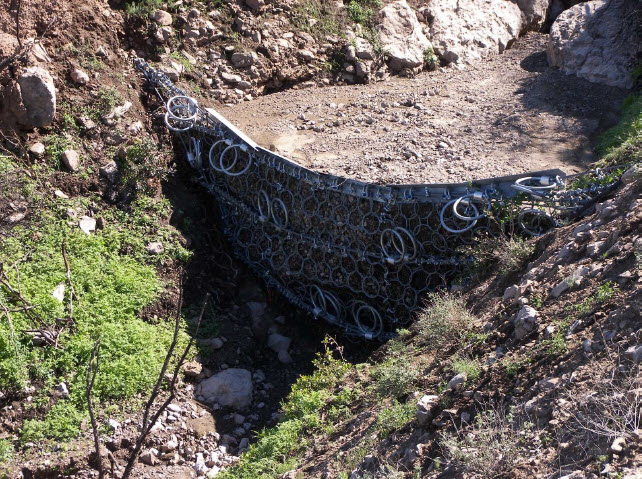
Eleven months ago, a small band of private citizens met informally at Cottage Hospital; each was separately visiting friends and loved ones injured by the mudslides. They began talking about what Montecito could do to prevent a repeat catastrophe. Their solution was to form a non-profit 501(c)(3) to investigate ways to lessen the risk of future debris flows and to help restore confidence in the safety and security of living in Montecito.
Partnership members Les Firestein, Gwyn Lurie, and Brett Matthews, all Montecito Union School parents and board members or spouses, researched potential worldwide solutions to debris flows and discovered that the most effective solution in this area’s steep terrain would be to install high-tensile steel ring nets to hold back or even stop such flows. They were drawn to a highly rated Swiss company – GeoBrugg – and learned that the kind of nets they believed would be needed were manufactured in Albuquerque, New Mexico.
Here Comes the January 2019 Miracle
Did anyone believe that community volunteers could possibly raise the money, engineer a plausible protection solution, obtain emergency permits, and install anything in time for this year’s rainy season? Count me among the doubters. Without an office, without a management structure and with no full-time workers, the Partnership has raised $2 million already, and have another million in pledges from donors waiting for permit approval.
Emergency one-year permits have now been approved. Within a week or two, it is hoped that installers will be working at six sites, drilling into canyons and installing anchors. The steel nets will then be dropped in by helicopter and bolted in place. Six GeoBrugg ring nets are on order for delivery in January—two to be installed in Cold Spring Canyon, two in San Ysidro Canyon, and two in Buena Vista Canyon. Installation of the remainder of the approved 11 nets is dependent on future fundraising.
Cold Spring Canyon Nets
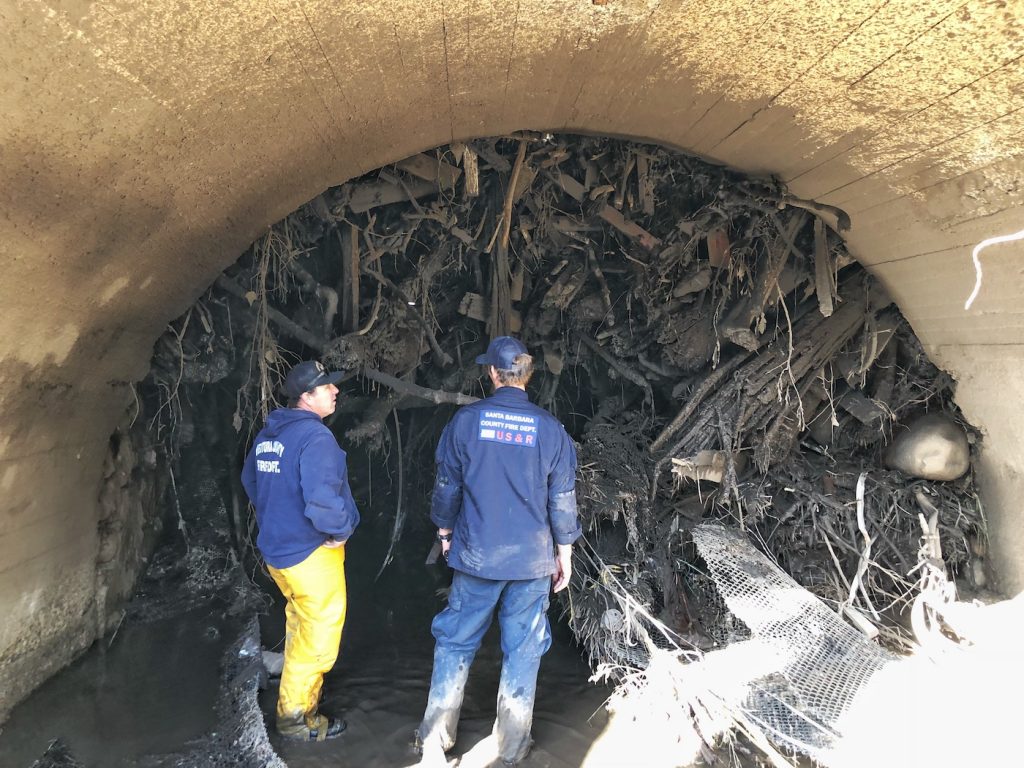
Cold Spring Creek joins with Hot Springs Creek and becomes Montecito Creek, where multiple deaths were recorded at East Valley and Parra Grande Lane. Two steel hoop nets, designed to trap as much as 9,000 cubic yards of boulders and logs above the existing Cold Spring Debris Basin, are to be installed on private land owned by the Mary K. Robinson Living Trust, according to the public permit applications. Final contracts with the landowners, guaranteeing them freedom from legal liability, are currently being negotiated.
The existing Cold Spring Debris Basin was built in 1964 by the U.S. Army Corps of Engineers after the Coyote Fire. It was designed to trap 20,000 cubic yards of flood debris. Its current capacity has deteriorated to 9,775 cubic yards. Now, the installation of two new ring nets will nearly double the capture capacity of that basin.
San Ysidro Canyon Nets
San Ysidro Creek accounted for deaths at Randall Road and East Valley. Two ring nets are scheduled to be located above the San Ysidro Ranch. The two nets will provide additional capture capacity of 15,434 cubic yards. The landowner, Ty Warner, is identified in the permit application as Wilderness BB, LLC.
The current San Ysidro Creek Debris Basin, located at the end of West Park Lane, was also built in 1964 by the Army Corps of Engineers following the Coyote Fire. Designed to capture 11,000 cubic yards, silting has reduced its capture capacity to 7,945 cubic yards. The new ring nets will add nearly 200% to that capacity.
Buena Vista Canyon Nets
Buena Vista Creek has no debris basins. Although permitted for seven ring nets, only two will be installed in January due to fiscal constraints. The remaining five nets will be added as soon as funding is available. The Buena Vista nets will be installed on private land belonging to the Thomas and Peggy Pollock Trust, as soon as written agreements with the landowners to indemnify them from lawsuits can be concluded. The Buena Vista Creek overflowed on 1/9 when a clogged culvert caused the creek to jump its banks, tearing through nearby neighborhoods.
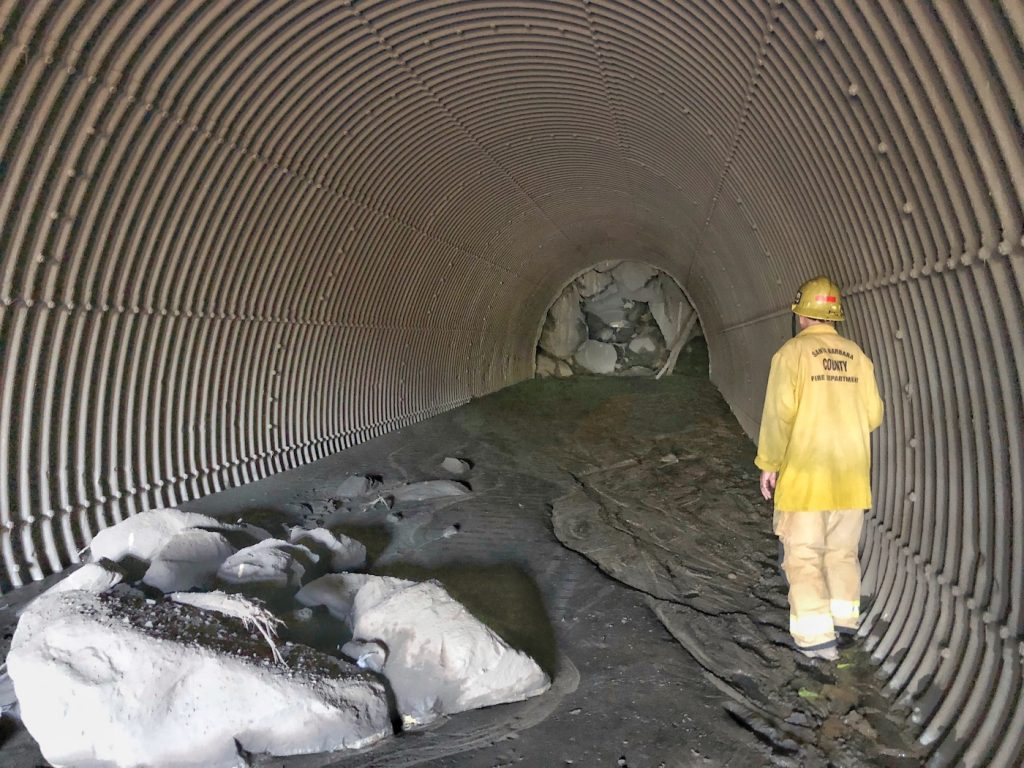
Debris Basins versus Ring Nets
Debris basins are essentially man-made, scooped-out dirt holes behind low dams designed as catch basins to collect water and debris. During storms, the water runs either over the dam or through a hole in the bottom of the basin, which can become blocked by the accumulated debris. Elevated ring nets allow wildlife to pass under the nets in dry times and allow water to flow under and through the nets in periods of high intensity rainfall, leaving behind the trapped trees and boulders. Debris basins require years of CEQA (California Environmental Quality Act) review; the proposed ring nets do not.
There are some 11 debris basins protecting Montecito and Carpinteria. The Crown Jewel is the massive Santa Monica Debris Basin built in 1977 for the Carpinteria Valley Watershed Project by the USDA Soil Conservation Service in response to major flooding along Franklin and Santa Monica Creeks in 1969. Its 208,000 cubic yard capacity proved large enough to save Carpinteria from the devastation and death that struck Montecito in January a year ago.
Financing the Ring Nets
Originally pegged at a cost of $5.4 million for 11 nets, the estimated cost has now risen to $7.4 million to pay for the new permitting conditions. That triggers a need for more community support, with a target of an additional $2 to 3 million in donations over the next 30-days from the private sector.
To be successful, broad-based community participation is needed with a goal of 75% of the homes and businesses in the “extreme danger” zone becoming small to medium donors, and 50% of the homes and businesses outside the extreme danger zone chipping in, no matter how small the donation.
Broad-based community support will allow the Partnership to fulfill its planned and permitted installations. It may also help to convince insurers to continue to write fire and flood policies in Montecito; persuade homeowners to rebuild with a higher level of confidence; and, most importantly, protect property values and save Montecito lives. The Partnership funding effort is being led by Alixe Mattingly, community advocate, and Brett Matthews, public-private partnership entrepreneur.
You Can Help Make it Happen
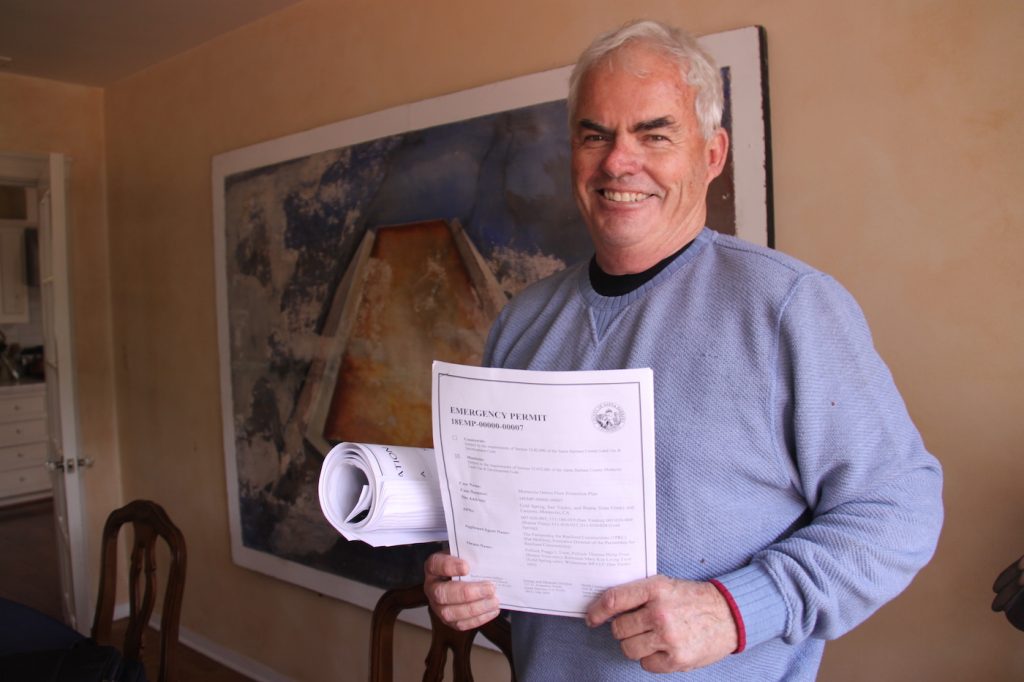
Ring net contractors and installers tell us this is the first time ever that community volunteers and private donors have contracted for their own debris flow security. All other installations have involved disaster relief entities like FEMA or other state, county or federal government agencies.
Without available public funding, we Montecito residents must take action to become more self-reliant and protect ourselves. I am not a public fundraiser. However, in the case of the community ring net effort, I am proud to step forward with a personal donation. Please join me in making a fully tax-deductible gift.
If you would like to meet or speak with a Partnership member to discuss a gift, please call Alixe Mattingly at (805) 886-6584. E-mail either alixemattingly@gmail.com or Hollye Jacobs at holly@frollye.com, or go directly to the www.partnershipsb.org website, click on “donate” and make a tax-deductible donation to the Santa Barbara Foundation, which is providing administrative support for this fundraising effort.
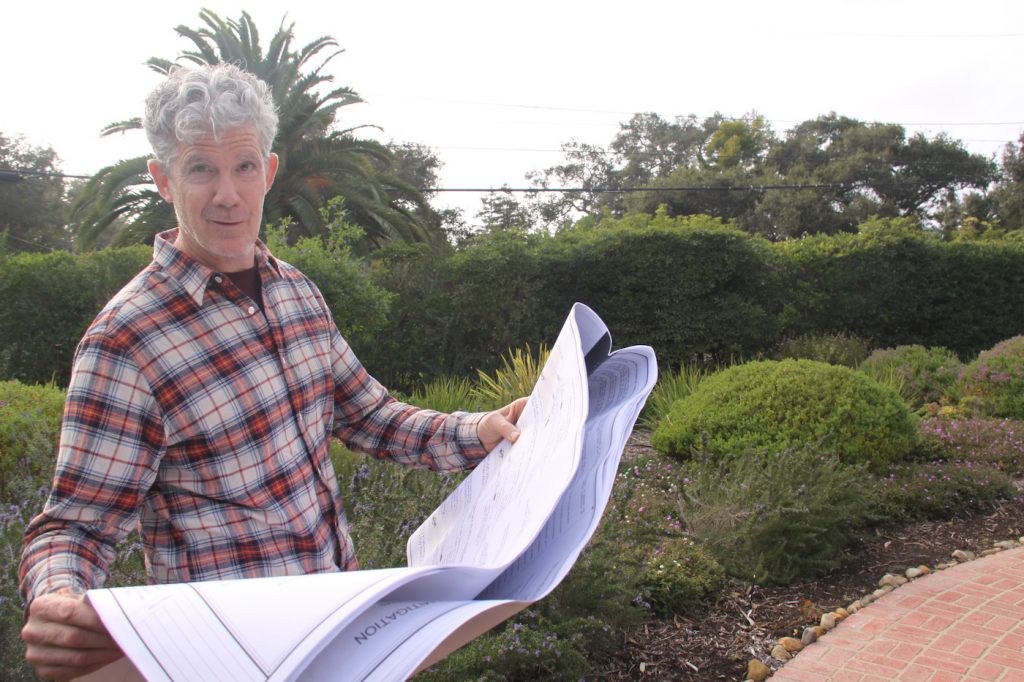
Alternatively, drop off or mail a check, payable to Resilient Communities, at the offices of Joe Cole, Attorney, 1482 East Valley Road, Montecito, 93108, in the Upper Village, a few doors north of the Post Office.
Montecito is, was, and will continue to be – with help from you and other like-minded folk – one of the most desirable places to live in… the world.







You must be logged in to post a comment.